The Trustees: Greenwood Farm

Right after my walk at Hamlin Reservation, I went to another site maintained by The Trustees of Reservations, Greenwood Farm in Ipswich, MA. The 216-acre property contains a short, g-shaped walking trail and a pair of historic houses, which won the 1998 and 2001 Mary P. Conley Preservation Awards given by Ipswich Historical Commission. While the site does not include much information about the three “dynasties” who lived on the property, these people are by far the most interesting part of the story.



The older building, called Paine House, was originally constructed around 1694 as verified by one of our favorite museum buzzwords, dendrochronology. This First Period colonial building is unique in its extreme saltbox design: the steeply slanting roof of the three-story house ends about four feet from the ground on the back side. The Paine family, also spelled Payne, had first arrived in Massachusetts in the mid-17th century and were led by patriarch Robert Paine, Sr. While he owned the land at the address now called 47 Jeffrey’s Neck Road, his son Robert Paine, Jr. built Paine House. The family was highly educated, as the younger Robert graduated from Harvard College in 1656, only fourteen years after the first graduation in 1642. Unfortunately, the younger Robert is best known for his work as a foreman of the Grand Jury during the Salem Witch Trials of 1692.



The property received its name from Thomas Smith Greenwood, the owner for fifty-five years between 1828 and 1883. He built the whitewashed farmhouse and worked as a farmer, but his other jobs included shoemaker, mariner, and Ipswich Lighthouse keeper. His most daring rescue of shipwreck victims was in 1839, and the Humane Society of the Commonwealth of Massachusetts gave him a medal for his heroism. This organization is not related to a similarly named non-profit that rescues animals. Instead, it was formed in 1786 to reward brave people who rescued others in emergencies, with the most common award given for water rescues. Since 2002, The Humane Society has worked with the United States Coast Guard and continues to provide grants to community organizations who train Massachusetts residents on First Aid and rescue techniques.



The second house on the property is Dodge House, a summer home belonging to the family of lawyer Robert Gray Dodge, which they owned beginning in 1916. Like Robert Paine Jr., Dodge graduated from Harvard and was well-connected to other important local political figures. As a member of the Dodge family, who first arrived in Massachusetts Bay Colony in 1629, he may have been considered part of the Boston Brahmin. During the height of his career, Dodge was known as “the dean of the Massachusetts bar”, since he founded the Massachusetts Bar Association in 1909. Other members of the family included his wife Alice Dodge, oldest daughter Katharine Gray Dodge Brownell and her husband, Harvard-educated lawyer George A. Brownell; seemingly unmarried middle daughter Sally Dodge; and youngest daughter Alice Langdon Dodge Wolfson Herling and her first husband, Broadway playwright Victor Wolfson, along with their son Thomas Wolfson (who was not cited in Dodge’s obituary despite becoming possibly the most interesting person in the family).



Greenwood Farm is open from dawn to dusk every day of the year. An unpaved lot provides plenty of parking. The lower portion of the trail can be slightly soggy after a long rain, so wear boots if you dislike damp socks. This site has two stops on the Trustees Remembrance Trail, part of Climate Futures, a speculative environmental project that imagines damage to current sites on the North Shore due to climate change. The grassland is predicted to become marsh in 2075, while the high water mark will reach a spot near the top of a hill by 2079. Be sure to visit this spot within the next fifty years to avoid these changes.